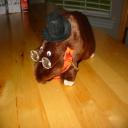Yahoo Answers is shutting down on May 4th, 2021 (Eastern Time) and the Yahoo Answers website is now in read-only mode. There will be no changes to other Yahoo properties or services, or your Yahoo account. You can find more information about the Yahoo Answers shutdown and how to download your data on this help page.
Trending News
Same calculus question thats been floating around for over a week...?
Plz just help in anyway you can. I'm not purposely being lazy, I, and many others in my class, are completely lost. the best I can figure is just set the rest of the variables to 1?...but in other problems, like ones involving Poiseuille's law, the of r tuns to 0...which would make 5. equal zero. PLEASE PLEASE PLEASE help us!
5. Research indicates that the power P required by a bird to maintain flight is given by the formula
P(v) = w^2/2pSv + 1/2 p A v^3
where v is the relative speed of the bird, w is its weight, p is the density of the air, and S and A are constants associated with bird’s size and shape. What speed will minimize the power expended by the bird? Assume that w, p , S, and A are positive constants.
1 week ago
6. The production of blood cells plays an important role in medical research involving leukemia and other so-called dynamical diseases. In 1977, a mathematical model was developed by A. Lasota that involved the cell production function
P(x) = Ax^s e^(-sx/r)
where A, s, and r are positive constants and x is the number of granulocytes (a type of white blood cell) present. Find the granulocyte level x that maximizes the production function P. How do you know it is a maximum?
1 Answer
- kbLv 77 years agoFavorite Answer
5) Do you mean P(v) = w^2/(2 p S v) + (1/2) p A v^3
or P(v) = (w^2/(2 p S)) v + (1/2) p A v^3
**Please clarify the placement of the parentheses so I can answer this properly.
-------------
6) P'(x) = Asx^(s-1) * e^(-sx/r) + Ax^s * (-s/r)e^(-sx/r)
............= As e^(-sx/r) x^(s-1) [1 - (x/r)s], by factoring
Setting P'(x) = 0 yields 1 - (x/r)s = 0 ==> x = s/r. (We ignore x = 0.)
Since P'(x) > 0 for x < s/r (try x = (1/2)(s/r)), and P'(x) < 0 for x > s/r (try x = 2s/r),
we conclude that x = s/r yields a maximum.
-------------
I hope this helps!




